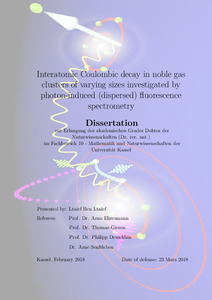| dc.date.accessioned | 2018-06-06T12:16:12Z | |
| dc.date.available | 2018-06-06T12:16:12Z | |
| dc.date.issued | 2018-06-06 | |
| dc.identifier.uri | urn:nbn:de:hebis:34-2018060655622 | |
| dc.identifier.uri | http://hdl.handle.net/123456789/2018060655622 | |
| dc.language.iso | eng | |
| dc.rights | Urheberrechtlich geschützt | |
| dc.rights.uri | https://rightsstatements.org/page/InC/1.0/ | |
| dc.subject | Fluorescence spectroscopy | eng |
| dc.subject | Spectrometry | eng |
| dc.subject | Synchrotron radiation | eng |
| dc.subject | inner-valence excitation | eng |
| dc.subject | supersonic beams | eng |
| dc.subject | Clusters | eng |
| dc.subject | electronic relaxation | eng |
| dc.subject | Neon | eng |
| dc.subject | Interatomic/moleculer Coulombic decay | ger |
| dc.subject.ddc | 500 | |
| dc.title | Interatomic Coulombic decay in noble gas clusters of varying sizes investigated by photon-induced (dispersed) fluorescence spectrometry | eng |
| dc.type | Dissertation | |
| dcterms.abstract | The main topic of this thesis is to study experimentally an ultrafast and efficient non radiative mechanism – the well-known interatomic Coulombic decay (ICD) – in noble gas clusters by employing fluorescence spectrometry technique in combination with synchrotron radiation. Using Neon clusters as prototype systems, a special variety of ICD, termed resonant ICD (RICD), has been investigated by a selective excitation of one component of the cluster and for different mean cluster sizes. The first part of the thesis was devoted to observe new open cluster fluorescing decay channels following ICD, reveal the associated resonant ICD (RICD) process, and hence, extensively characterize its radiative final states. Here, simultaneous measurements of undispersed vacuum ultraviolet (VUV) and UV/visible photons emitted from 2s inner-valence-excited Neon clusters were made. At first glance, the observed cluster features in the measured VUV fluorescence yield suggest that the initially created 2s inner-valence state in Neon cluster relaxes predominantly by a spectator RICD. At second glance, the direct correspondence of the structures observed in the measured VUV and UV/visible cluster fluorescence signals implies that the final states of the spectator RICD release their excess energy by photon emission cascade: First, by the Rydberg-to-Rydberg transitions in the UV/visible spectral range, and then, by the Rydberg-to-valence transition in the VUV range. To trace the decay pathway during this radiative cascade, an additionally dispersed VUV fluorescence measurement was performed for the most intense RICD fluorescence feature. The second part of the thesis concerns investigation of VUV fluorescence emission from Neon clusters of varying sizes after excitation with photons of energies near and far below the 2s-electron photoionization thresold of Neon atoms. In the Neon 2s-regime, the cluster size-dependent VUV fluorescence excitation functions of Neon clusters show a series of distinct cluster fluorescence features; four of which are attributed to the resonant 2s \to np (n = 3, 4, 5, 6) excitations of cluster-surface atoms and one to 2s \to 3p excitation of cluster-bulk atoms. Included in these are the ones emerged from spectator RICD which are found to be visible for all cluster sizes but appear to be less prominent in the VUV fluorescence excitation functions of the larger clusters due to additional structureless fluorescence emission that increases with increasing cluster size. This emission has a threshold energy of 35.8 eV and is observed increasing almost linearly with energy at lower exciting-photon energy. It is interpreted as due to inelastic scattering of the initially outgoing 2p photoelectrons with condensed neutral Neon atoms. Due to the longer escape length of photons versus electrons emitted from dense matter, this work in general brings about a possibility of using fluorescence spectrometry as a potential detection sheme to reveal interatomic/molecular electronic processes in real dense media towards understanding, for example, the details of radiation damage in living tissues such as DNA double-strand breaks. | eng |
| dcterms.accessRights | open access | |
| dcterms.creator | Ben Ltaief, Ltaief | |
| dc.contributor.corporatename | Kassel, Universität Kassel, Fachbereich Mathematik und Naturwissenschaften | |
| dc.contributor.referee | Ehresmann, Arno (Prof. Dr.) | |
| dc.contributor.referee | Giesen, Thomas (Prof. Dr.) | |
| dc.contributor.referee | Demekhin, Philipp (Prof. Dr.) | |
| dc.contributor.referee | Senftleben, Arne (Dr.) | |
| dc.subject.swd | Neon | ger |
| dc.subject.swd | Zerfallsreaktion | ger |
| dc.date.examination | 2018-03-23 | |

